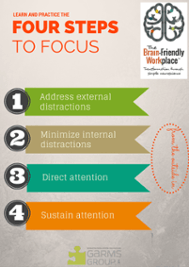
By Erika Garms PH.D., CSP
In my last blog, I shared several big ideas about focus:
- There are four aspects to corralling and sustaining focus:

- It’s likely that one or two of the aspects above is a bigger challenge for you than the others (click) HERE for a quick self-assessment to help you pinpoint your challenge area(s)
- Focus exists along a continuum (it’s not binary — either ON or OFF)

- There is no bad place on this continuum – they are all purposeful and we benefit from being able to shift when we want to. For example, when our pre-frontal cortexes tire of being creative or from doing planning work, we may need to “mentally defrag” by letting ourselves go into a “Drift” state. Here, actual changes occur in the brain that help with information encoding, learning, insight, memory, and recall.
As you can see, we’ve been misunderstanding . . . well, “under-understanding” focus. With a bit more complexity than we may have thought there was to the concept of FOCUS, we can actually start to see our variable focus as a TOOL . . . as an advantage to help us do our best work.
Here are some suggestions for how to take advantage of the state you’re in, and for how to shift to a different spot when desired. . .
When you’re in “Drift” and want to capture the ideas that come across your mind in this free-association state:
Keep equipment near you to enable you to easily jot down a few words about the thoughts in your mind without completely pulling yourself out of the state. I like to use audio recording on my phone. Others use pen and paper, a tablet, the Evernote app, large, blank paper or whiteboard. There are as many possibilities for capturing as there are productivity apps in the App Store! One other suggestion: soon after you’ve left this state of mind, return to your notes (or recording) to add detail to what you recorded while in Drift. This expansion of your notes will help you recall more fully what you had in your mind at a future time. And, you may not recognize the value of these thoughts until reflecting on them later.
When you need to leave “Drift” and direct your attention to something specific:
- Create a small, specific goal to identify the task you want to accomplish right now.
- Identify a time-frame for working towards this goal (keep it small, say 15-20 minutes to begin).
- Run through the FOUR STEPS TO FOCUS to help sharpen focus from the outside in, solving trouble spots as you discover them.
- Go! Dive in to the task and continue to monitor and eliminate distractions.
Now, on the other end of the focus continuum, when you’ve been fully in “Flow” but now need to interact or be more connected to others:
- Jot down a short description (or draw a sketch) of what was last on your mind in the “Flow” state, to help you return to that when desired.
- If there are any loose-threads or thoughts that you do not want to lose track of, also jot them down to return to later. Develop a system/habit for taking and keeping these kinds notes so that you aren’t creating chaos through unorganized bits of information surrounding you.
- Physically set aside the tools you were working with in your Flow state (could be your computer, a notepad, tablet, research)
- Shift physically (stand, reposition, get a drink, eat, take a deep breath)
- Now, reset mentally . . . either state aloud or in your mind, the desire you now have to return to connection with others and WHY (focus on the goal or result). Perhaps the goal is simply to conserve “Flow” energy for another time when you will devote all attention to the task again. Remember, your brain(and body) needs breaks in the kind of thinking it does.
- (For a 3-minute exploration of the concept of “Flow”, check out this video by Jason Silva!)
When you’re in “Flexible Focus” and want to use your time most wisely:
- Try blocking your time and tasks
- Give yourself no more than 60 seconds to jot down a list of the tasks you’d like to address
- Cluster them according to the kind of thinking required (ex. idea generation, decision-making/problem-solving, transactional or administrative). This is a very efficient way to use your mental energy and your time.
- Working in 10 or 20-minute time chunks, work through one cluster at a time, avoiding the allure of task-switching (if you’re not familiar with it yet, check out the Pomodoro Technique)
- If a thought interferes with the task you are working on, write it down and leave it
- Again, run through the FOUR ASPECTS OF FOCUS to eliminate distractions from the outside in
- When you feel internal resistance or waning energy, it may be time to let yourself return to Drift. Physical activity can be a great idea at this point, even a gentle walk around the building.
SUMMING UP:
The brain is always working. And, it tires easily of the same kind of thinking over a long time period. It creates its own “time outs” but pulling itself between “Drift” and “Flow.” Instead of considering focus something you must continually battle to achieve – fighting your own tendencies to drift or to over-focus – learn to appreciate the benefits of all places along the focus continuum and that your brain is a smart machine! It knows (sometimes better than our conscious minds do) when you need a change in scene or another type of shift in work.
This article was originally posted at erikagarms.com.
Erika Garms, PH.D., CSP is a faculty member of LEADERSHIP USA.